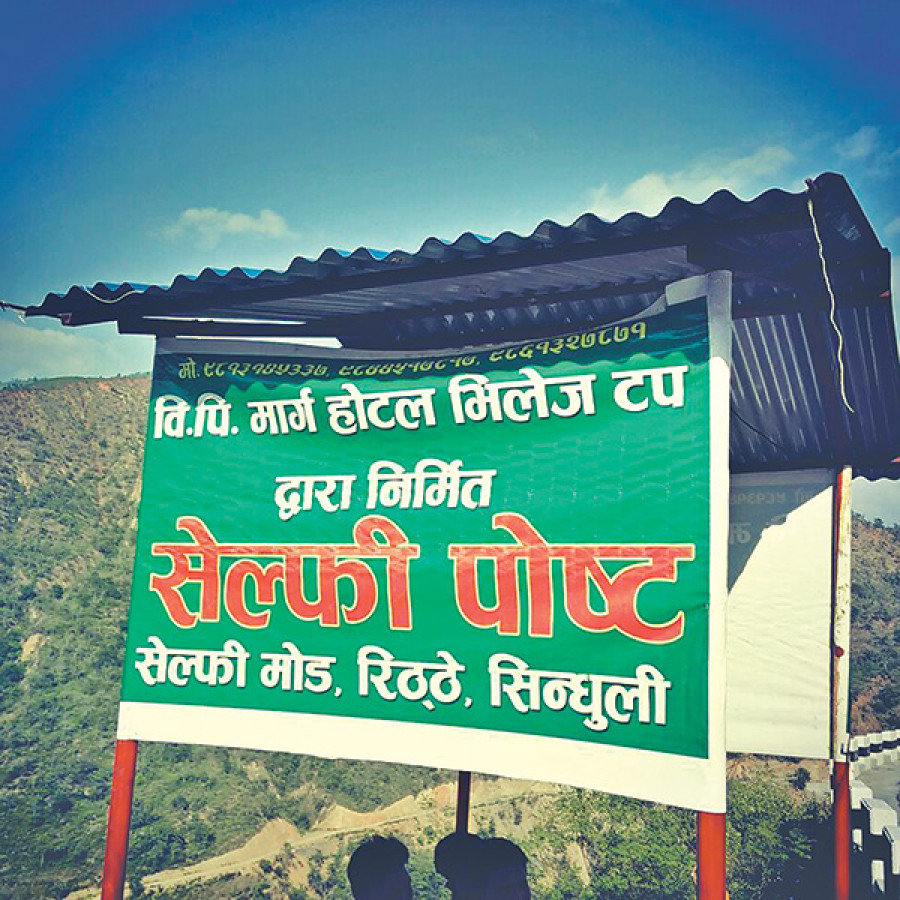Miscellaneous
Enchanted at Selfie Hill
Manholes swallow school girls whole. Buses and micros paraglide off highways. Something slipped, we come to hear. In some cases it was the attention of the driver, and in others, it was the tyres that skidded because small boulders never got removed after a landslide.
Sandesh Ghimire
Manholes swallow school girls whole. Buses and micros paraglide off highways. Something slipped, we come to hear. In some cases it was the attention of the driver, and in others, it was the tyres that skidded because small boulders never got removed after a landslide.
Only the onslaught of the harsh monsoon reminds the government that reconstruction and repair work on Nepal’s roads is urgently needed.
When accidents happen, our prayers go out for the deceased, momentarily. But we cope and forget and continue on with our lives.
Is it that we Nepalis are unnaturally resilient, or have we just become apathetic? New roads and new highways have been built for us to ply on, but our attitude remains unchanged.
After the BP Highway, which connects Dhulikhel to Bardibas, came into operation, it became the shortest route to connect Kathmandu with the eastern Tarai belt; and TATA sumos and micros were quick to capitalise on the route.
When I purchased my ticket a week before Dashain, I was reassured that I would be travelling with no more than 16 people.
But as I boarded the micro on the day of departure, I counted 18 heads. By the time the micro forked onto the highway at Dhulikhel, there were 22 people, not counting the toddlers.
We were packed into the vehicle like the proverbial Gundruk, but the driver kept insisting: “Alik milera basnus ta, ajai ek jana lai thau cha.” (Could you adjust the way you are seated? There is room for one more.) How Nepali transport entrepreneurs manage to squeeze in so many people into one micro is a mystery only the khalasis understand.
Once we were finally on our way, the old engine adamantly climbed and angrily descended on the highway that had the hills of Sindhuli wrapped like a serpent.
The micro bus jolted frequently at every steep turn of the barely-two-lane highway. The instinctive fear from such frequent shocks, and having internalised the danger of travelling on speeding vehicles on Nepali highways through grisly images and news reports, all passengers were sweating profusely before long.
All along, corroding road signs reminded the driver not to speed above 20 km/h. But who was listening? Who was watching? Did anyone care?
Curiously, throughout the journey, many fellow passengers complained to the driver and the khalasi about the congestion. Why were so many people cramped into the vehicle when we were promised otherwise? some asked. Others moaned about the infrequencies of toilet breaks or the dysfunctional A/C.
Not one voice was heard raised against the obvious speeding. Reckless driving, we had all seemed to accept, came part and parcel with trying to move from any point A to point B in this country.
Eventually, all of our unspoken anxieties came to a head when we stopped for an hour at a scenic overlook with an intriguing history behind it.
Dubbed the Selfie Danda (Selfie Hill), the view point has become a popular stopover for vehicles headed into Bardibas, but not entirely because of the sweeping panoramic views it affords for the foggy valley below.
Alarmed by the high number of accidents on the highway, authorities implemented a time card system last year, under which a vehicle ferrying passengers has to take at least five hours to traverse the highway.
But like most other government directives, we Nepalis have found a way-around. Instead of checking their over speeding, drivers who ply the BP Highway race on a usual and instead take a long stopover at the scenic hill to fulfil the mandatory time limit.
The site became so popular that eventually even private vehicles, which are not subject to the time card system, started making stops. Now, the hill is known as Selfie Hill. It is one of several such outlooks that dot the highway, serving the same function.
Selfie Danda is also one of the few spots on the highway where the phone networks work seamlessly.
Which is why, no sooner we stopped there, all my co-passengers were instantly glued to their phones.
Our pent-up anxieties now dissipated, we all got busy snapping up selfies and posting them on social networking sites.
The wide grins on our faces belied the harrowing few hours we had spent in the micro getting there.
The all-enveloping fog cooled down our worries and it was as if the over speeding, the reckless driving, the discomfort and the persistent fear were all a far-off dream. A figment of our weary imaginations.
The truth was that in this age of double lives, Selfie Danda was not just a scenic stopover but a pilgrimage site, and we, armed with our cellphones, were devotees paying homage. In this Brave New World, Facebook is our soma.
Having spent a short hour, and fulfilled the government time limit, we departed from Selfie Hill rejuvenated. The complaints about discomfort stopped.
Even the crying of the infants magically ceased. Maybe it was because our phones had consistent network for the remaining leg of the journey.
The adults got busy counting the likes stacking up on their recently-posted selfies, the children were seduced by the popular Motu Patlu cartoons, unbeknownst to the fact that Nepali highways have a serious problem. And we obliging travellers are a large part of it.




 9.12°C Kathmandu
9.12°C Kathmandu










